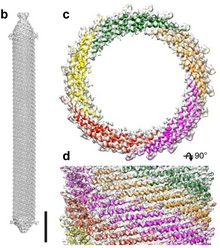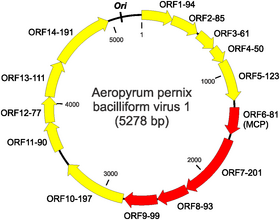Clavaviridae: Difference between revisions
Daviszrh123 (talk | contribs) No edit summary |
→External links: + ViralZone |
||
| (36 intermediate revisions by 23 users not shown) | |||
| Line 1: | Line 1: | ||
{{Short description|Family of viruses}} |
|||
{{Taxobox |
|||
{{Italic title}} |
|||
| color = violet |
|||
{{Virusbox |
|||
| name = |
|||
| image = ODD.Clava.Figure 1.v2-Claviviridae-APBV1 (a).png |
|||
| image = |
|||
| image_caption = |
| image_caption = ''Aeropyrum pernix bacilliform virus 1'' (APBV1) |
||
| ⚫ | |||
| virus_group = i |
|||
| ⚫ | |||
| ⚫ | |||
* Aeropyrum pernix bacilliform virus 1 |
|||
| subdivision_ranks = Genera |
|||
| ⚫ | |||
''[[Clavavirus]]'' |
|||
}} |
}} |
||
'''''Clavaviridae''''' is a family of double-stranded viruses that infect archaea. There is one genus in this family (''Clavavirus''). Within this genus, |
'''''Clavaviridae''''' is a family of double-stranded viruses that infect [[archaea]]. This family was first described by the team led by D. [[David Prangishvili|Prangishvili]] in 2010.<ref name=Mochizuki2010 /> There is one genus in this family (''Clavavirus''). Within this genus, a single species has been described to date: ''[[Aeropyrum pernix bacilliform virus 1]]'' (APBV1).<ref>{{cite journal |last1=Prangishvili |first1=David |last2=Mochizuki |first2=Tomohiro |last3=Liu |first3=Ying |last4=Krupovic |first4=Mart |last5=ICTV Report Consortium |title=ICTV Virus Taxonomy Profile: Clavaviridae |journal=Journal of General Virology |date=2019 |volume=100 |issue=9 |pages=1267–1268 |doi=10.1099/jgv.0.001295 |pmid=31271351 |doi-access=free }}</ref> |
||
The name is derived from the [[Latin]] word ''clava'' meaning stick. |
The name is derived from the [[Latin]] word ''clava'' meaning stick.{{cn|date=August 2023}} |
||
==Virology== |
==Virology== |
||
[[File:ODD.Clava.Figure 1.v2-Claviviridae-APBV1 (bcd).png|thumb|left|3D reconstruction of the virion structure of ''Aeropyrum pernix bacilliform virus 1'' (APBV1). Scale bar 10 nm.]] |
|||
<!--[[File:Clavaviridae virion.jpg|thumb|''Clavaviridae'' virion]] -- looks strange --> |
|||
The virons are bacilliform in shape and 143 nanometers (nm) in length and 15.8 nm in diameter.<ref name=Mochizuki2010>{{cite journal |vauthors=Mochizuki T, Yoshida T, Tanaka R, Forterre P, Sako Y, Prangishvili D |title=Diversity of viruses of the hyperthermophilic archaeal genus Aeropyrum, and isolation of the Aeropyrum pernix bacilliform virus 1, APBV1, the first representative of the family ''Clavaviridae'' |journal=Virology |volume=402 |issue=2 |pages=347–54 |year=2010 |pmid=20430412 |doi=10.1016/j.virol.2010.03.046 |doi-access=free }}</ref><ref name=struct>{{cite journal|last1=Ptchelkine|first1=D|last2=Gillum|first2=A|last3=Mochizuki|first3=T|last4=Lucas-Staat|first4=S|last5=Liu|first5=Y|last6=Krupovic|first6=M|last7=Phillips|first7=SEV|last8=Prangishvili|first8=D|last9=Huiskonen|first9=JT|title=Unique architecture of thermophilic archaeal virus APBV1 and its genome packaging.|journal=Nature Communications|date=10 November 2017|volume=8|issue=1|pages=1436|doi=10.1038/s41467-017-01668-0|pmid=29127347|pmc=5681674|bibcode=2017NatCo...8.1436P}}</ref> One end is pointed and the other is rounded. The structure of the APBV1 virion has been solved by cryo-electron microscopy to near-atomic resolution, revealing how the helical particle is built from an alpha-helical major capsid protein with a unique structural fold.<ref name=struct /> Virions are highly thermostable and remain infectious after incubation at 100 °C for 3 h{{cn|date=November 2022}} |
|||
[[File:ODD.Clava.Figure 3.v4-Claviviridae-APBV1-genome.png|thumb|left|upright=1.25|APBV1 genome map]] |
|||
The virons are bacilliform in shape and ~140 nanometers (nm) in length and 20 nm in diameter.<ref name=Mochizuki2010>Mochizuki T, Yoshida T, Tanaka R, Forterre P, Sakob Y, Prangishvili D (2010) Diversity of viruses of the hyperthermophilic archaeal genus ''Aeropyrum'', and isolation of the Aeropyrum pernix bacilliform virus 1, APBV1, the first representative of the family ''Clavaviridae''. Virology 402(2): 347-354</ref> One end is pointed and the other is rounded. |
|||
The genome is a circular double-stranded DNA molecule of 5.3 kb. It does not integrate into the host genome. The genome contains 14 open reading frames, none of which share similarity with sequences in public databases.{{cn|date=November 2022}} |
|||
| ⚫ | |||
The genome is double-stranded DNA and circular. It does not integrate into the host genome. |
|||
{{clear}} |
|||
| ⚫ | |||
==References== |
==References== |
||
{{reflist}} |
{{reflist}} |
||
==External links== |
|||
* [http://www.ictv.global/report/clavaviridae '''ICTV Report:''' ''Clavaviridae''] |
|||
* [https://viralzone.expasy.org/2918 '''ViralZone:''' ''Clavaviridae''] |
|||
{{Taxonbar|from=Q5129590}} |
|||
{{Taxonbar|from=Q18818574}} |
|||
{{Taxonbar|from=Q18967864}} |
|||
| ⚫ | |||
[[Category:Virus families]] |
|||
{{virus-stub}} |
|||
| ⚫ | |||
Latest revision as of 15:30, 31 March 2024
| Clavavirus | |
|---|---|

| |
| Aeropyrum pernix bacilliform virus 1 (APBV1) | |
| Virus classification | |
| (unranked): | Virus |
| Family: | Clavaviridae |
| Genus: | Clavavirus |
| Species | |
| |
Clavaviridae is a family of double-stranded viruses that infect archaea. This family was first described by the team led by D. Prangishvili in 2010.[1] There is one genus in this family (Clavavirus). Within this genus, a single species has been described to date: Aeropyrum pernix bacilliform virus 1 (APBV1).[2]
The name is derived from the Latin word clava meaning stick.[citation needed]
Virology[edit]

The virons are bacilliform in shape and 143 nanometers (nm) in length and 15.8 nm in diameter.[1][3] One end is pointed and the other is rounded. The structure of the APBV1 virion has been solved by cryo-electron microscopy to near-atomic resolution, revealing how the helical particle is built from an alpha-helical major capsid protein with a unique structural fold.[3] Virions are highly thermostable and remain infectious after incubation at 100 °C for 3 h[citation needed]

The genome is a circular double-stranded DNA molecule of 5.3 kb. It does not integrate into the host genome. The genome contains 14 open reading frames, none of which share similarity with sequences in public databases.[citation needed]
Infection with this virus does not cause host cell lysis.[citation needed]
References[edit]
- ^ a b Mochizuki T, Yoshida T, Tanaka R, Forterre P, Sako Y, Prangishvili D (2010). "Diversity of viruses of the hyperthermophilic archaeal genus Aeropyrum, and isolation of the Aeropyrum pernix bacilliform virus 1, APBV1, the first representative of the family Clavaviridae". Virology. 402 (2): 347–54. doi:10.1016/j.virol.2010.03.046. PMID 20430412.
- ^ Prangishvili, David; Mochizuki, Tomohiro; Liu, Ying; Krupovic, Mart; ICTV Report Consortium (2019). "ICTV Virus Taxonomy Profile: Clavaviridae". Journal of General Virology. 100 (9): 1267–1268. doi:10.1099/jgv.0.001295. PMID 31271351.
- ^ a b Ptchelkine, D; Gillum, A; Mochizuki, T; Lucas-Staat, S; Liu, Y; Krupovic, M; Phillips, SEV; Prangishvili, D; Huiskonen, JT (10 November 2017). "Unique architecture of thermophilic archaeal virus APBV1 and its genome packaging". Nature Communications. 8 (1): 1436. Bibcode:2017NatCo...8.1436P. doi:10.1038/s41467-017-01668-0. PMC 5681674. PMID 29127347.
External links[edit]
